Quando tentamos fazer login em nossos próprios sites do WordPress, há ocasiões em que a página de login continua sendo atualizada e redirecionada, impedindo-nos de acessar a área de administração do WordPress.
Se você está passando por isso, não está sozinho. O problema de atualização e redirecionamento da página de login do WordPress é comum e frustra muitos proprietários de sites WordPress. Dito isso, testamos vários métodos testados e verdadeiros para resolver o problema.
Neste guia abrangente, mostraremos como corrigir o problema de atualização e redirecionamento da página de login do WordPress. Vamos mergulhar de cabeça e levá-lo de volta ao painel do WordPress para que você possa recuperar o controle do seu site!
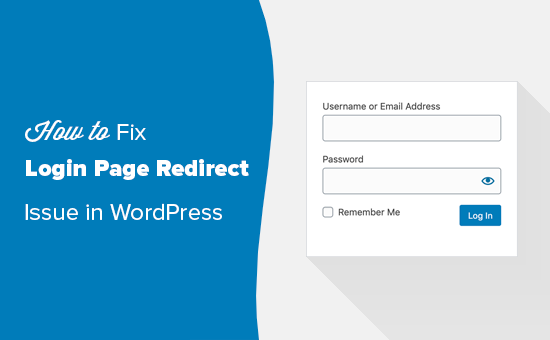
O que causa o problema de atualização e redirecionamento da página de login no WordPress?
O erro de atualização e redirecionamento da página de login do WordPress (também chamado de loop de redirecionamento de login do WordPress) geralmente é causado por configurações incorretas de URL do WordPress ou falha na definição de cookies de login.
Normalmente, quando você faz login, o WordPress valida seu nome de usuário e senha e, em seguida, define um cookie de login no seu navegador. Depois disso, ele o redireciona para o painel do WordPress.
Se o WordPress não conseguir definir o cookie de login corretamente ou se o URL da área de administração do WordPress estiver incorreto, você será redirecionado para a tela de login em vez do painel de administração.
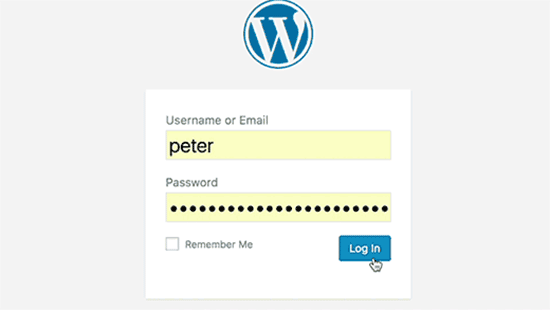
Os problemas de login também podem ser causados por diferentes erros do WordPress, como o erro ao estabelecer conexão com o banco de dados, erro interno do servidor ou a tela branca da morte.
Com isso em mente, vamos solucionar e corrigir o problema de redirecionamento e atualização da página de login do WordPress. Você pode usar esses links rápidos para ir para um método específico:
- Method 1: Clear Cookies to Resolve Login Issues
- Method 2: Update WordPress URL Settings
- Method 3: Delete .htaccess File in WordPress
- Method 4: Deactivate Your Plugins
- Method 5: Revert Back to the Default Theme
- Method 6: Reinstall WordPress Core
- Video Tutorial
- What to Do If You Can't Fix WordPress Login Redirect Issue
Observação: se você quiser experimentar as etapas avançadas deste tutorial do WordPress, crie primeiro um backup do seu site. Consulte nosso guia sobre como criar manualmente um backup do banco de dados do WordPress.
Método 1: Limpar cookies para resolver problemas de login
O WordPress usa cookies para autenticação de login, portanto, a primeira etapa na solução de problemas de login do WordPress é a mais simples. Você precisará limpar os cookies e o cache do navegador.
No Google Chrome, basta clicar no menu de configurações do navegador e selecionar Mais ferramentas ” Limpar dados de navegação.
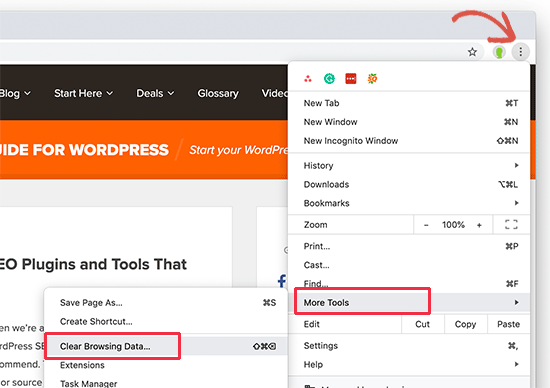
Isso abrirá a página Configurações do Chrome com um pop-up “Limpar dados de navegação” exibido na tela.
A partir daí, você precisa selecionar as opções “Limpar cookies e outros dados do site” e “Imagens e arquivos armazenados em cache”.
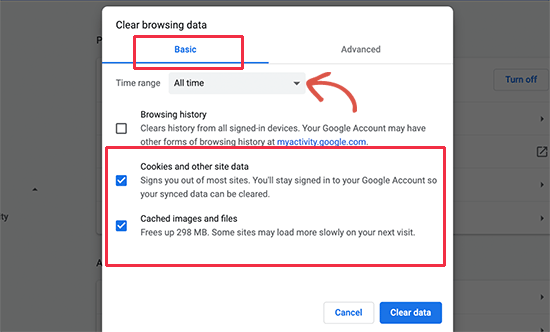
Em seguida, clique no botão “Limpar dados”, e o Google Chrome limpará o cache do navegador.
Além disso, certifique-se de que seu navegador tenha os cookies ativados. Depois de fazer isso, reinicie o navegador e tente fazer login. Isso deve corrigir o problema para a maioria das pessoas.
Temos um guia completo com capturas de tela que mostram como limpar o cache e os cookies em todos os principais navegadores.
Método 2: Atualizar as configurações de URL do WordPress
O WordPress vem com configurações para a URL de seu site e a URL de sua instalação do WordPress.
Se você tiver acesso à área de administração do WordPress, poderá ver essa opção na página Configurações ” Geral.
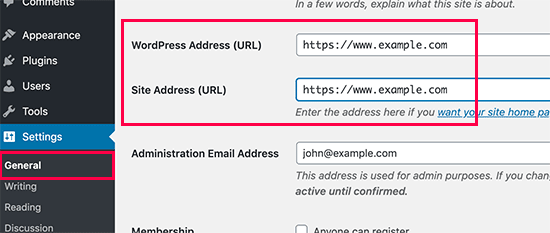
Se esses URLs estiverem incorretos, o WordPress o redirecionará de volta para a página de login.
Como não é possível acessar a área de administração do WordPress, você precisará editar o arquivo wp-config.php para corrigir esse problema.
O arquivo wp-config.php é um arquivo especial no WordPress que contém suas configurações importantes do WordPress. Você pode acessá-lo usando um cliente FTP ou por meio do aplicativo File Manager no painel da sua conta de hospedagem do WordPress.
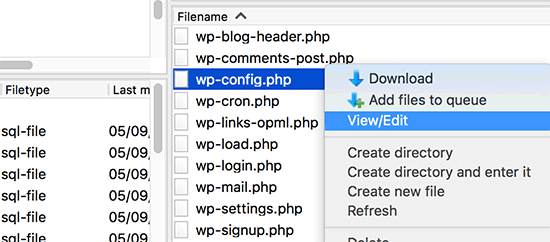
Você encontrará o arquivo wp-config.php na pasta raiz do seu site. Basta editar o arquivo e colar as seguintes linhas de código logo antes da linha que diz: "Isso é tudo, pare de editar! Feliz publicação".
define('WP_HOME','https://www.example.com');
define('WP_SITEURL','https://www.example.com');
Não se esqueça de substituir “example.com” por seu próprio nome de domínio.
Depois disso, salve as alterações e carregue o arquivo de volta em seu site.
Agora você pode visitar o site do WordPress e tentar fazer login. Esperamos que isso tenha resolvido o problema para você. Caso contrário, continue lendo para ver outras etapas de solução de problemas.
Método 3: Excluir o arquivo .htaccess no WordPress
Às vezes, o arquivo .htaccess pode ser corrompido, o que pode resultar em erros internos do servidor ou no erro de atualização da página de login.
Basta acessar seu site usando um cliente FTP ou por meio do aplicativo File Manager no painel do seu provedor de hospedagem.
Uma vez conectado, localize o arquivo .htaccess no diretório raiz do seu site e faça o download para o seu computador como um backup.
Se você não conseguir encontrar o arquivo .htaccess, este guia sobre por que o arquivo .htaccess pode estar ausente poderá ajudá-lo.
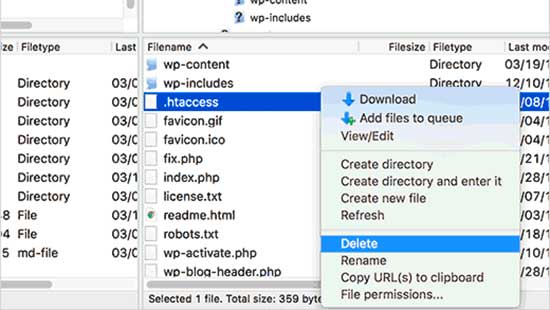
Depois disso, vá em frente e exclua o arquivo .htaccess de seu site.
Em seguida, abra o diretório wp-admin e, se houver um arquivo .htaccess lá, vá em frente e exclua-o também.
Agora você pode tentar fazer login no site do WordPress. Se conseguir, isso significa que o arquivo .htaccess estava impedindo que você fizesse login no WordPress.
Depois de fazer o login, basta acessar a página Configurações ” Permalinks no painel de administração do WordPress e clicar no botão “Salvar” sem fazer nenhuma alteração. Isso gerará um novo arquivo .htaccess para seu site.
Método 4: Desativar seus plug-ins
Às vezes, os plug-ins do WordPress podem causar esse problema, especialmente se houver um conflito entre dois plug-ins.
Para desativar facilmente todos os seus plug-ins do WordPress, conecte-se ao seu site usando um cliente FTP ou por meio do aplicativo Gerenciador de arquivos no painel da sua conta de hospedagem na Web.
Depois de conectado, vá para o diretório /wp-content/. Dentro dele, você verá uma pasta chamada “plugins”. É nessa pasta que o WordPress instala todos os seus plug-ins.
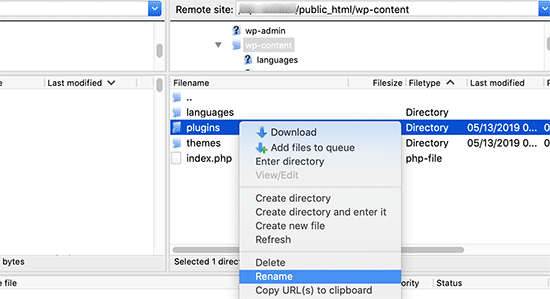
Basta renomear a pasta de plug-ins para “plugins_backup”. Isso desativará todos os plug-ins do WordPress instalados em seu site.
Também temos um tutorial detalhado sobre como desativar todos os plug-ins do WordPress quando o administrador do WordPress estiver inacessível.
Depois de desativar todos os plug-ins, tente fazer login no site do WordPress. Se tiver êxito, isso significa que um dos plug-ins estava causando o problema.
Método 5: Reverter para o tema padrão
Os temas do WordPress também podem causar conflitos após a atualização para uma versão mais recente do WordPress ou do próprio tema. Para descobrir se o problema está sendo causado pelo seu tema, será necessário desativá-lo.
O processo é semelhante ao da desativação de plug-ins. Conecte-se ao seu site usando um cliente FTP. Em seguida, vá para o diretório /wp-content/themes/ e renomeie o diretório do tema atual para “themes_backup”.
Depois de fazer isso, tente fazer login novamente. Se tiver sucesso, isso significa que seu tema estava causando o problema.
Agora você pode reinstalar uma nova cópia do tema para ver se isso resolve o problema. Se o problema reaparecer, será necessário entrar em contato com o suporte do seu tema ou mudar para um tema diferente do WordPress.
Método 6: Reinstalar o núcleo do WordPress
Em casos raros, o problema de atualização persistente da página de login pode ser causado por arquivos corrompidos do núcleo do WordPress.
Esses arquivos principais são a base do seu site WordPress e gerenciam as funcionalidades essenciais. Se esses arquivos forem danificados ou substituídos por códigos incorretos, isso pode levar a vários erros, inclusive problemas de login.
Primeiro, acesse o site WordPress.org e faça o download da versão mais recente do software. Após o download, descompacte o arquivo em seu computador. Isso criará uma pasta chamada “wordpress” que conterá todos os arquivos necessários para a reinstalação.
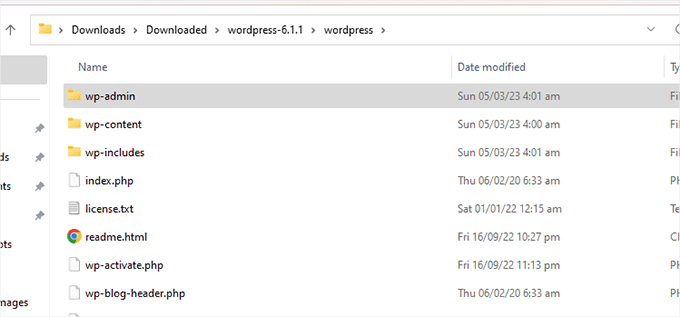
Em seguida, você precisará se conectar ao seu site usando um cliente FTP ou o gerenciador de arquivos fornecido pela empresa de hospedagem.
Depois de conectado, navegue até a pasta raiz de seu site. Esse é o diretório principal que contém pastas como wp-admin, wp-content e wp-includes.
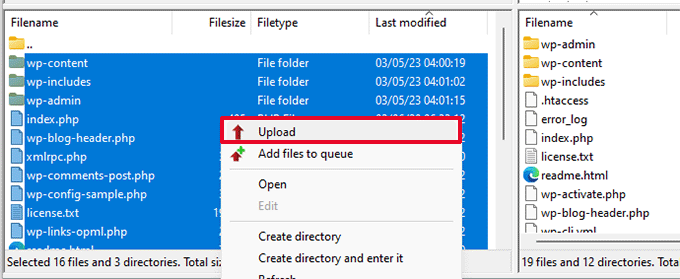
Nesta etapa, pegue todos os arquivos da pasta “wordpress” em seu computador e carregue-os no diretório raiz do seu site.
Seu cliente FTP solicitará que você confirme a substituição de quaisquer arquivos principais existentes.
Como você está excluindo arquivos corrompidos do núcleo do WordPress e substituindo-os por novos, escolha “Overwrite” e selecione a opção “Always use this action” para evitar a necessidade de confirmar cada arquivo individualmente.
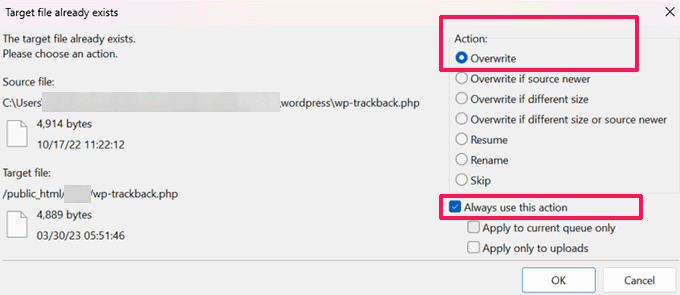
Por fim, clique em “OK” para iniciar o processo de upload. Seu cliente FTP substituirá os arquivos principais do WordPress em seu site pelos arquivos novos do seu computador.
Após a conclusão do upload, visite seu site para ver se o erro foi corrigido. Se o problema de login for causado por um arquivo principal corrompido ou por malware, a mensagem de erro deverá desaparecer e você poderá fazer login com êxito.
Tutorial em vídeo
Se você precisar de instruções visuais, assista ao vídeo abaixo.
O que fazer se você não conseguir corrigir o problema de redirecionamento de login do WordPress
Se você já tentou de tudo, desde a limpeza de cookies do navegador até a desativação de temas e plug-ins, mas o problema persiste, pode tentar solicitar suporte na comunidade do WordPress.
Os usuários de grupos como o grupo WPBeginner Engage no Facebook podem ter tido o mesmo problema que você e podem fornecer dicas sobre o que fazer para resolver os problemas da página de login.
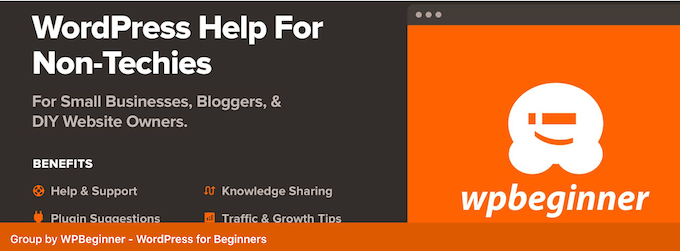
Além disso, você pode entrar em contato com soluções de suporte para WordPress, como o WPBeginner Pro Services. Oferecemos suporte premium de emergência para WordPress, no qual os especialistas podem identificar o que está acontecendo com seu site e resolver a causa raiz do problema.
Você também pode contratar nossos serviços de manutenção do WordPress para evitar que problemas como malware, alto tempo de inatividade e WordPress desatualizado afetem seu site.
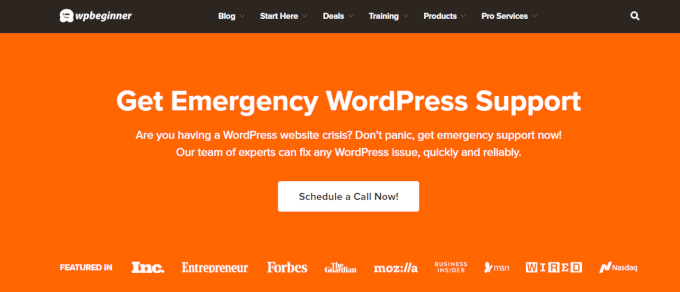
Sinta-se à vontade para marcar uma reunião com nossa equipe hoje mesmo para ver o que podemos fazer para corrigir seu site.
Saiba mais Soluções de solução de problemas do WordPress
Você está enfrentando outros erros comuns do WordPress e precisa encontrar uma maneira de corrigi-los? Aqui estão outros artigos que você pode conferir:
- Como corrigir o problema do erro “Too Many Redirects” no WordPress
- Como corrigir facilmente o erro This Site Can’t Be Reached no WordPress
- Como corrigir a mensagem “O site está enfrentando dificuldades técnicas” no WordPress
- Como corrigir o erro 404 dos posts do WordPress (passo a passo)
- Como corrigir o erro de conteúdo misto no WordPress (passo a passo)
- Como corrigir o erro de JSON inválido no WordPress (guia para iniciantes)
- Como localizar e acessar os registros de erros do WordPress (passo a passo)
- Como corrigir o problema de não envio de e-mail no WordPress
- Como corrigir o WordPress travado no modo de manutenção (a maneira fácil)
Esperamos que este artigo tenha ajudado você a resolver o problema de atualização e redirecionamento da página de login do WordPress. Talvez você também queira ver nosso guia completo de solução de problemas do WordPress ou conferir nossas principais opções dos melhores plug-ins e ferramentas do WordPress para expandir seu site.
Se você gostou deste artigo, inscreva-se em nosso canal do YouTube para receber tutoriais em vídeo sobre o WordPress. Você também pode nos encontrar no Twitter e no Facebook.





Amnon Jakony
Deleting htaccess file worked fine for me…
WPBeginner Support
Glad to hear it was able to help you!
Admin
Harry k
Thanks for this video and the post. I tried above all of your methods but none of them fixed the issue. read the comment and found a solution as below. Edit HTTPS to HTTP.
define(‘WP_HOME’,’https://example.com’);
define(‘WP_SITEURL’,’https://example.com’);
to
define(‘WP_HOME’,’http://example.com’);
define(‘WP_SITEURL’,’http://example.com’);
WPBeginner Support
The issue with this method would be that your site would start to show the not secure message as your site would not be using HTRTPS. This can be a temporary workaround but you would want to update your site to use HTTPS after you are able to log in.
Admin
Tobias
No luck none of them worked
WPBeginner Support
If none of the methods from this article are working for you, we would recommend reaching out to your hosting provider for them to check if there are any errors on their end.
Admin
Salah
Thanks a lot,
You saved my day,
I have changed the file wp-config.php as described in the tutorial and that worked for me.
My best regards.
WPBeginner Support
Glad to hear our guide was helpful!
Admin
Robert clancy
I messed around with the Update WordPress URL Settings
and that was a world of pain to correct as it took my whole site down. I had to correct it through changing the config settings using FTP.
WPBeginner Support
The settings are definitely powerful and can cause issues if you change them incorrectly. Glad you were able to fix the issue using FTP!
Admin
DK John
Your first method worked for me. Thank you for this magical guide
WPBeginner Support
Glad our guide was helpful!
Admin
David Kuteesa
Tried all and none worked. Here is what worked:
Went to wp-config.php and set define( ‘WP_DEBUG’, false); to define( ‘WP_DEBUG’, true );
Tried logging in again and got “usermeta table missing” error.
Thats when I realised I had a missing table. Got it from another installation and changed the table prefix to meet current db.
Worked immediately
WPBeginner Support
Thank you for sharing this, for most beginners we recommend reaching out to their hosting provider if our recommendations do not work as they can check for less beginner friendly errors.
Admin
Stian
Thank you – that tip about restoring the admin page by adding two lines of code in the config file seems to work nicely (still crossing fingers), but I have hope now, which I didn´t earlier.
WPBeginner Support
We hope it helps!
Admin
WPBeginner Support
Glad our guide could help and if you hadn’t set up SSL before changing to https that would definitely be the most likely cause.
Admin
branhampaul
Thank You, it worked.
I initially had the siteurl & wp address url changed to “https”, and this made me unable to log-in my dashboard. Maybe because I had not ssl at my host set-up.
Re-changing the “https” to “http” helped me log-in back.
Bryan Veloso
Everything didn’t work. But after downgrading my PHP from 7.4 to 7.2, I was able to login.
Kinda weird, now I’m using an older PHP version.
Did you encounter an issue similar to mine? I want to use the newer PHP version, but it doesn’t let me login in wp-admin.
WPBeginner Support
More than likely, you may have a plugin causing a conflict, you would want to start by following our troubleshooting guide below:
https://www.wpbeginner.com/beginners-guide/beginners-guide-to-troubleshooting-wordpress-errors-step-by-step/
Admin
Alisha
This issue has never happened to me before, but the 2nd / plugin option worked for me right away.
This website is a lifesaver! Thank you so much!
WPBeginner Support
Glad our guide was helpful
Admin
Øivind
Thank you! The wp-config.php-metod worked for me!
WPBeginner Support
Glad our recommendation was able to assist
Admin
Ruta
I tried some of these steps, but the problem turned out to be elsewhere: my site was setup as a ‘multisite’ but in wp-config file it said ‘subdomain_install’ as ‘false’, when I changed it to ‘true’, I could login to the site normally without redirects
WPBeginner Support
Glad you found the solution to the issue
Admin
Jerry
This was also my problem! I tried all the steps mentioned in the article, but after changing the ‘subdomain_install’ from false to true in the wp-config.php file it worked!!
Thanks!!
Joe
I have been trying to solve this for MONTHS… Thanks to your comment, I was able to fix it in about 10 seconds. Thank you so much for sharing!
This should be included in the tutorial.
Brayton Scott
Awesome, and simply tutorial. 1st suggestion fixed my site.
WPBeginner Support
Glad our recommendation could help
Admin
Fraser
I followed the instructions to deactivate all plugins and I now have access to wp-admin again! The instructions were easy to follow, and thanks so much for putting them out there.
WPBeginner Support
Glad our article was helpful
Admin
Sachin Baikar
Thanks for this great help. The plugin folder renaming worked for me. There was an issue with one of the plugins. Thanks once again
WPBeginner Support
Glad our recommendations were able to help
Admin
E
Thank you for this article. It is a complete lifesaver.
WPBeginner Support
Glad our guide was helpful
Admin
Philipp
I was looking for a solution for over 5 hours now – nothing worked. But deleting the htaccess file in the wp-admin directory helped!
I cant thank you enough.
Made my day.
WPBeginner Support
Glad our recommendation helped
Admin
María González
Thank you! You just saved my life (at least my job!) and a loooot of time (:
WPBeginner Support
Glad our guide was able to help
Admin
Suraj Handa
Hey but now its showing that cookies are disable in your browser please enable cookies. What can I do now?
WPBeginner Support
There are a few possible reasons for a starting point, you may want to clear your cookies and cache to be safe. For a starting point, you may want to take a look at our article below:
https://www.wpbeginner.com/beginners-guide/how-to-clear-your-cache-in-wordpress
Admin
charlie
just refresh the page, the wordpress app reacts like that because it suddenly sees no more cookies
ajay mali
you are always post great content that really helps a lot to everyone. thank you so much.
WPBeginner Support
You’re welcome
Admin
David Cuff
Very helpful. Thank you!
WPBeginner Support
You’re welcome
Admin
ibrahim zouadi
Thank you for sharing those tips, unfortunately none of them have worked for me. I even uninstalled the whole wordpress plugin. I don’t know what should i do next
WPBeginner Support
For the next step, you would want to take at our article below:
https://www.wpbeginner.com/beginners-guide/beginners-guide-to-troubleshooting-wordpress-errors-step-by-step/
Admin
Anthony
This helped like charm
Many thanks.
WPBeginner Support
You’re welcome
Admin
PDN Social
This was a lifesaver! We were able to follow step-by-step and avoid a major problem!
Great information!
WPBeginner Support
Glad our guide was helpful
Admin
Jasmeet Singh
I couldn’t find my wp admin page. It shows
“There has been a critical error on your website. Please check your site admin email inbox for instructions.
Learn more about debugging in WordPress.”
How can I fix this error?
WPBeginner Support
For that specific error, you would want to follow our guide below:
https://www.wpbeginner.com/wp-tutorials/how-to-fix-the-wordpress-white-screen-of-death
Admin
cristi
Hi, i have change by mistake my url and now the domain wp admin login url bring me to other site and i cont have ftp access how i can change back them?
WPBeginner Support
You can either reach out to your hosting provider or if you have phpMyAdmin access you could change the options table and update the URL and address.
Admin
Ankit
define(‘WP_HOME’,’https://www.example.com’);
define(‘WP_SITEURL’,’https://www.example.com’);
where do these two lines add in wp-config.php file?
At Last OR At Start?
Please clarify
WPBeginner Support
As we state in the article: paste the code just before the line that says ‘That’s all, stop editing! Happy publishing’.
Admin
Paek
Thank you so much!!!
Adding the wp-config lines solved it.
Thanks!
WPBeginner Support
You’re welcome
Admin
Ada
Thank you so much for your post. I’m a newbie with WP. These lines worked for me
define(‘WP_HOME’,’http://example.com’);
define(‘WP_SITEURL’,’http://example.com’);
I also changed the below line from false to true.
define( ‘WP_DEBUG’, true );
WPBeginner Support
Glad our recommendation could help, the WP_Debug you should be able to return to false should you want
Admin
mojo
thank u so much after spending so much time after deleting that .htacces and restart my mac open the website finally thanks for ur time
WPBeginner Support
You’re welcome, glad our recommendations could help
Admin
Goxi
You safe my life man! Just messed around the login wp admin site if it wasn’t for this tutorial I would never have solved the problem!
WPBeginner Support
Glad our guide was helpful
Admin
Tomer
Thank you very much for this tutorial!
I have tried these methods and managed to temporarily fix the problem.
The thing is, that after everything seems to be working again, the next day it happens again. Without me changing anything at all. Any tips on that?
WPBeginner Support
You would want to reach out to your hosting provider to ensure there is nothing on their end that could be causing this conflict
Admin
Sulivan
For those who ended up here an after all steps could’t solve this, check if you changed table prefix. I have changed mines and just figured out that there are some usermeta that stores the old prefix.
WPBeginner Support
Thanks for sharing what was the issue on your site
Admin
shahin
thank you bro , amazing content and very useful
WPBeginner Support
Glad you like our content
Admin
Julie
Tks a lot ! You save me !
WPBeginner Support
You’re welcome, glad our guide could help
Admin
Ann
Thanks a lot to all of you, and specially to Hand: Changing back php version to 7.3 solved this for me!
WPBeginner Support
Glad the recommendations could help you
Admin
Hand
I had this issue and spent an entire day trying every possible solution mentioned here and elsewhere without any progress. Then I remembered that I had changed the PHP version from 7.3 to 7.4 on my hosting’s control panel (DirectAdmin). Changing back php version to 7.3 solved this for me.
WPBeginner Support
Thanks for sharing the solution that worked for you
Admin
Jeff
This worked for me.
Joe
I’ve just worked out that PHP 7.4 missed three of the extensions we had installed on PHP 7.3:
php74-php-opcache
php74-php-process
php74-php-soap
As soon as they were enabled and provisioned the wp-admin 404 error disappeared. Hope that helps you to upgrade to 7.4 trouble-free!
Shiv
Hi
I followed this article and in my case i found one plugin was causing this issue.So it found it by renaming each plugin and keep trying the login and once i reached this plugin and renamed it …admin login worked.So…i renamed back rest of the plugins to their original names and keep this once renamed and admin worked and later i sorted my plugin
Thanks
WPBeginner Support
Glad you were able to get your site working and thanks for sharing the method you used for other users with this issue
Admin
mark
I deleted the htaccess file as instructed, and now I can’t get a login screen at all. No access to my site (404)
WPBeginner Support
To check for the possible issues, you would want to go through the steps in our article here: https://www.wpbeginner.com/beginners-guide/beginners-guide-to-troubleshooting-wordpress-errors-step-by-step/
Admin
Di
Thanks, you’re a life saver. The .htaccess hack worked!
WPBeginner Support
Glad our recommendation could be helpful
Admin
gho
I owe you one! I used the codes and it’s simply worked. Big thanks wpbeginner!
WPBeginner Support
Glad our guide could help
Admin
Giang Nguyen
thanks man. Your Update Site URL works!
I tried to manually install piece by piece in my local macbook, to learn how wordpress work, and missing your piece!
The install manual doesn’t really have this kind of info =)
giang
WPBeginner Support
Glad our recommendation could help you
Admin
Todd
I’ve had this issue before many years ago and I think my fix was the same this time as it was then. After trying many many suggestions above, what finally did it for me was clearing my chrome browsing history. Someone mentioned trying that and not working, but this was not actually offered as a solution so I thought I would post it. Thanks!
WPBeginner Support
Thanks for sharing what worked for you
Admin
Peter
I was having a login error where my login page keeps refreshing and redirecting me back to the login screen. And for me (I tried all of the above solutions) and none of them worked.
Then I checked the error_log file on my WordPress site and saw that the problem I was having said “WordPress database error Disk full”
As a result, I went into my wp-config.php file and added the following code to file right above the text line where it says in the file “* That’s all, stop editing! Happy blogging. */”.
The code I added is:
define(‘WP_MEMORY_LIMIT’, ‘256M’);
Problem solved.
WPBeginner Support
Thanks for sharing the solution that worked for you
Admin
Chris
Thanks for this – it worked perfectly and tehe memory limit solved the problem. I was really angry because all other stuff like plugins, themes, .htaccess didn’t work!!!
Greetigs Chris
purushotham
i am not able to login my wordpress admin ,getting 404 error.what should i do to reslove the issue.
WPBeginner Support
For a starting point, you would want to reset your permalinks using: https://www.wpbeginner.com/wp-tutorials/how-to-fix-wordpress-posts-returning-404-error/
If that does not solve the error then you could try the troubleshooting steps in our guide here:
https://www.wpbeginner.com/beginners-guide/beginners-guide-to-troubleshooting-wordpress-errors-step-by-step/
Admin
Travis
None of these options worked for me… Turns out to be a hosting issue. Called Network Solutions and they said that because my database was over 300mb I needed to upgrade my database because after 300mb they lock you out…. Upgrading by DB fixed the issue. Who knew….?!
WPBeginner Support
Glad you were able to find the solution to the problem
Admin
Chris
How did you upgrade the WP database? I think this may be my problem.
WPBeginner Support
You would reach out to your hosting provider and they would let you know if you need more space for your database similar to Travis
Admin
hamdi
Defining these lines ON TOP OF wp-config.php helped. They don’t help if you put them at the bottom.
define(‘WP_HOME’,’http://example.com’);
define(‘WP_SITEURL’,’http://example.com’);
WPBeginner Support
It should still work if you place it at the bottom of the wp-config file, there may have been a problem with where you placed it depending on what’s in your specific wp-config file.
Admin
Joe G
Nothing worked for me until I went into ftp server and edited index.php in the site’s root (alongside all of the other wp-related files mentioned here), and set define( ‘WP_USE_THEMES’, FALSE )
This will temporarily break your site temporarily (no error codes, just white screen), though my site loading wasn’t the problem. This allowed me to finally access my dashboard through the login site, where I then put a brand new theme on and fixed what I thought might be the culprit (I made the mistake of redirecting my “Home” link on my menu to an exterior site).
After removing the “Home” link, (or just to be safe, the menu in general), and creating a new menu with only the pages in question I wanted to use, I re-set the ‘wp_use_themes’ to TRUE and we’re back off to the races again!
WPBeginner Support
Thanks for sharing what worked for you
Admin